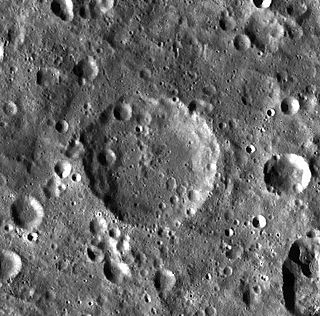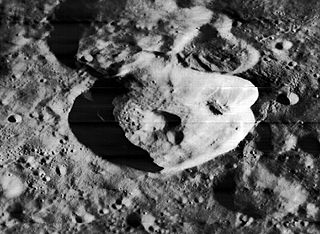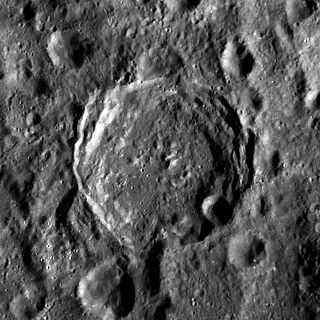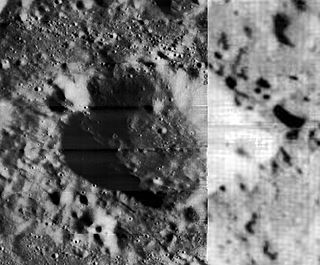 Lunar Orbiter 2 image (mosaic of high and low resolution images) | |
| Coordinates | 12°24′N173°18′E / 12.4°N 173.3°E Coordinates: 12°24′N173°18′E / 12.4°N 173.3°E |
|---|---|
| Diameter | 74 km |
| Depth | Unknown |
| Colongitude | 188° at sunrise |
| Eponym | Vsevolod Vasilievich Sharonov |

Sharonov is a lunar impact crater that lies on the Moon's far side. It is located to the southeast of the crater Anderson, and to the southwest of the ray-covered Virtanen. To the south-southeast of Sharonov lies Valier.

Lunar craters are impact craters on Earth's Moon. The Moon's surface has many craters, almost all of which were formed by impacts.

An impact crater is an approximately circular depression in the surface of a planet, moon, or other solid body in the Solar System or elsewhere, formed by the hypervelocity impact of a smaller body. In contrast to volcanic craters, which result from explosion or internal collapse, impact craters typically have raised rims and floors that are lower in elevation than the surrounding terrain. Impact craters range from small, simple, bowl-shaped depressions to large, complex, multi-ringed impact basins. Meteor Crater is a well-known example of a small impact crater on Earth.

Earth's Moon is an astronomical body that orbits the planet and acts as its only permanent natural satellite. It is the fifth-largest satellite in the Solar System, and the largest among planetary satellites relative to the size of the planet that it orbits. The Moon is, after Jupiter's satellite Io, the second-densest satellite in the Solar System among those whose densities are known.
Contents
This crater is roughly circular, with a slight outward bulge along the southern rim. The rim edge is well-defined and has not been significantly degraded as a result of impact erosion. Sharonov partially overlays the smaller crater Sharonov X along the northwestern rim, which in turn connects to the southeastern outer rim of Anderson. The inner walls of Sharonov display some terraces, especially along the northern half. The interior is not marked by any significant impacts, but there are some ridges near the midpoint.
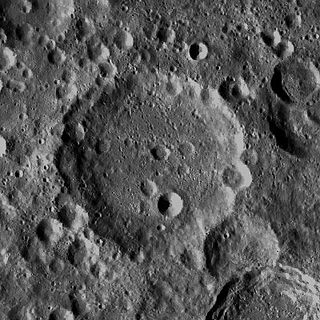
Anderson is a lunar impact crater that is located on the far side of the Moon. It is located to the northwest of the crater Sharonov, and the satellite crater Sharanov X is attached to the southeast rim of Anderson. To the northeast is the peculiar formation Buys-Ballot, and to the east-southeast lies the larger crater Spencer Jones.
Sharonov is probably part of the Eratosthenian System, but may be part of the Upper Imbrian System. [1]
The Eratosthenian period in the lunar geologic timescale runs from 3,200 million years ago to 1,100 million years ago. It is named after the crater Eratosthenes, which displays characteristics typical of craters of this age, including a surface that is not significantly eroded by subsequent impacts, but which also does not possess a ray system. The massive basaltic volcanism of the Imbrian period tapered off and ceased during this long span of lunar time. The youngest lunar lava flows identified from orbital images are tentatively placed near the end of this period.
The crater lies within the Freundlich-Sharonov Basin.
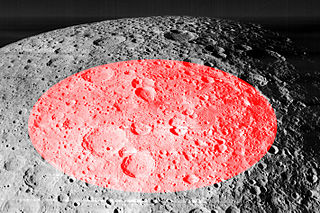
The Freundlich-Sharonov Basin is a Pre-Nectarian impact basin on the far side of the moon. It is named after the younger craters Freundlich near the northwest margin and Sharonov near the southwest margin. It lies east of Mare Moscoviense basin and northwest of Korolev basin.












